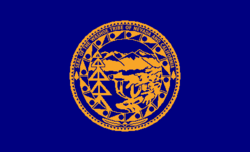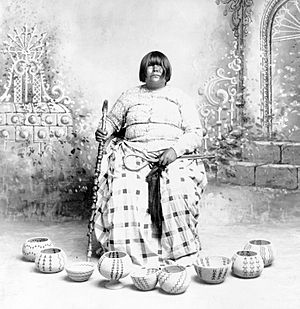Washoe people facts for kids

Washoe tribal flag
|
|
| Total population | |
|---|---|
| 1,500 (2007) | |
| Regions with significant populations | |
( |
|
| Languages | |
| English, Washo |
The Washoe or Wašišiw people are an Indigenous tribe of Native Americans. Their name, "Washoe," comes from their own language, meaning "people from here." They live near Lake Tahoe, which is on the border between California and Nevada.
Contents
Where Did the Washoe People Live?
The Washoe people have lived in the Great Basin and the eastern Sierra Nevada mountains for at least 6,000 years. Some people believe they have been there for as long as 9,000 years!
Before Europeans arrived, the Washoe people's land was mainly around Lake Tahoe. Lake Tahoe is called dáʔaw in the Washoe language, which means "the lake." Their territory stretched from Honey Lake in the north to Sonora Pass in the south. It also went from the Sierra Nevada mountains in the west to the Pine Nut Mountains in the east.
The Washoe people also used the upper parts of the Carson River, Truckee River, and West Walker rivers. They spent their summers in the Sierra Nevada, especially around Lake Tahoe. In the fall, they moved to the ranges in the east. During winter and spring, they lived in the valleys between these areas. Washoe Lake was named after them.
Washoe Regional Groups
The Washoe people were organized into a few main groups. These groups spoke slightly different versions of the Washoe language. Each regional group had smaller family groups that worked together for hunting and lived together in winter camps. The regional group was named after where people had their winter camp:
- Welmelti (Northern Washoe People)
- Pauwalu / Powalu (Central Washoe People)
- Hungalelti (Southern Washoe People)
- Tanalelti (Western Washoe People)
Because the western part of the Washoe land was very snowy, not many people spent the winter there. This meant the western group was quite small.
A Look at Washoe History
The Washoe people are unique among Great Basin tribes because their language is different from their neighbors. This suggests they lived in the area before other tribes arrived. Early Washoe culture, known as the Kings Beach Complex, appeared around Lake Tahoe about 1,500 years ago.
The Washoe people and the nearby Northern Paiute people were very different in their culture and language. Sometimes, these two tribes had conflicts.
The Washoe people might have met Spanish explorers in the early 1800s. However, they did not have regular contact with Europeans until the California Gold Rush in 1848. The Washoe tried to protect their lands, but it was difficult. The last armed conflict involving the Washoe and non-Native Americans was the Potato War of 1857. During this event, Washoe people who were starving were killed for gathering potatoes from a farm near Honey Lake.
As more settlers arrived, the Washoe lost their hunting grounds and pine nut groves. These areas were taken over for farms or to provide wood for Virginia City, Nevada. This forced most Washoe people to find jobs on ranches, farms, and in cities. The places where they settled became known as Indian colonies.
Washoe Culture and Daily Life

The Washoe people were very knowledgeable about their land and its resources. In the fall, they gathered piñon pine nuts, which were a main food source for the winter. They also ate roots, seeds, berries, and hunted animals throughout the year. They understood the seasonal cycles of plants and animals.
Fishing was also a very important part of Washoe life, especially at Lake Tahoe and nearby streams. Each family had its own fishing spots. However, when commercial fishing started in the area, it harmed this important resource for the Washoe.
Important ceremonies for the Washoe include the Pine Nut Dance and girls' puberty rites. In the past, medicine men used their knowledge of plants and ceremonies to help the community. Much of this traditional knowledge has been lost due to contact with the Western world.
Washoe culture was passed down through legends and storytelling. These stories taught younger generations about gathering food, preparing medicine, and how to respect the land. Family was very important, and everyone worked together. Older tribe members shared their knowledge with the young to keep their culture alive. Each family member had a role in daily tasks like fishing, gathering, or hunting, which made their lives more efficient.
How the Washoe People Lived Through the Year
The Washoe people got their food in three main ways: fishing, gathering, and hunting. Each method needed special skills. Because resources could be limited, the Washoe lifestyle was divided into three main periods:
- The Fishing Year: This period began in early spring when the snow melted. Some tribe members, mostly young men and boys, would leave their winter camps and go to Lake Tahoe to fish. This saved food for those who stayed behind. They used caves and shelters for warmth, along with clothes made from rabbit skin. They caught whitefish, eating some and bringing some back to the winter camps. As it got warmer, more families would travel to Lake Tahoe. By early June, almost everyone was involved in fishing. They caught and dried a lot of fish to save for later.
- The Gathering Year: Gathering food happened all year, but different types and amounts of food were available at different times. In winter, they mostly ate food they had gathered earlier. As spring arrived, more plants became available. Since food was spread out, the tribe would split into smaller groups to find it. Women usually did the gathering, while men fished or hunted.
- The Hunting Year: Hunting started in early spring when animals appeared. This was mainly a men's activity, and boys were trained from a young age. The Washoe hunted larger animals like deer, bears, and antelope, as well as smaller ones like rabbits, birds, and squirrels. They used different hunting methods for different animals.
Fall was the time with the most food, as all three ways of getting food could be done. Winter was often a time of scarcity, as food supplies ran low. However, the Washoe people learned to survive by wisely using the resources the land gave them. They knew that balancing fishing, gathering, and hunting was key to their survival.
The Washoe Language
The Washoe language (called Wašiw Wagayay today) is considered a unique language. Some experts think it might be part of the larger Hokan language family. The language is written using the Latin letters.
Today, the Washoe language is in danger of disappearing, with only a few older people speaking it fluently. However, there is a strong effort to bring the language and culture back. The "Wašiw Wagayay Maŋal" (which means "the house where Wašiw is spoken") was an early project to teach the language to new generations. The tribe's Cultural Resource Department now offers language classes. Recently, there has been a focus on teaching the language to young people.
The Washoe Tribe and Lake Tahoe
The Washoe people are the original inhabitants of the Lake Tahoe area. They have lived around the lake for thousands of years. As the native people, they believe they know best how to care for the land. They see themselves as the proper guardians of the Lake Tahoe area, which has always been a central place for their cultural gatherings and traditional events. In 2002, the U.S. government officially gave the Washoe Tribe of Nevada and California custody over some land around Lake Tahoe for cultural purposes.
Washoe Tribal Groups Today
Today, Washoe people are part of several recognized tribal groups:
Under the Indian Reorganization Act of 1934, the Washoe communities in the Carson Valley area of Nevada and California became officially recognized as the Washoe Tribe of Nevada and California. The community in Reno, Nevada, which also includes many Paiute and Shoshone people, gained separate recognition as the Reno–Sparks Indian Colony. Some Washoe members also live in the Susanville Rancheria, alongside other tribes like the Northern Paiute.
See also
 In Spanish: Washo para niños
In Spanish: Washo para niños


